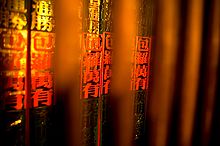- Tung Shing
-
Tung Shing 
Traditional Chinese 通勝 Simplified Chinese 通胜 Transcriptions Mandarin - Hanyu Pinyin tong1 sheng4 Cantonese (Yue) - Jyutping tung1 sing3 The Tung Shing (simplified Chinese: 通胜; traditional Chinese: 通勝; pinyin: Tōngshèng) is a Chinese divination guide and almanac. It consists primarily of a calendar based on the Chinese lunar year.
Contents
History
The Tung Shing originated from the Wong Lik (黃曆, the "Yellow Calendar"), which is rumoured to have been written by the Yellow Emperor. It has changed its form numerous times throughout the years during all the dynasties; the latest version was said to have been edited by the Qing dynasty and was called the Tung Shu (通書). Tung means "myriad" or "all", Shu means "book", so Tung Shu literally meant "All-knowing Book". However, in Cantonese and Mandarin, the pronunciation of the word for "book" is a homophone of a word for defeated, so Tung Shu sounded like "Defeated in All Things" (通輸). Therefore the name was changed to Tung Shing (通勝), which meaning "Victorious in All Things".[1]
Contents
Most of the contents of the book deals with what is suitable to do on each day. Some Chinese families still follow these days for wedding ceremonies, funerals, etc.
The most common use of the Tung Shing is in choosing a wedding date. The Tung Shing contains information on the auspicious and inauspicious days for weddings and/or engagements. In addition, it provides the auspicous timing in which to carry out such activities.
The Tung Shing also provide a conversion of years and date between the lunar year and the common year. In more detailed versions, the calendar will list eclipses (both solar and lunar), the start of each season, and days when it will be cold or hot. It also teaches ethics and values through stories.
Tung Shing versions in Hong Kong and Taiwan come from two late-Qing versions.[2][3] It[clarification needed] is known for its English definitions and words transliterated into Cantonese characters.
Gallery
Other specialties
- Interpret one's fate
- Measure one's soul weight (requires Four Pillars of Destiny)
- Face reading and palm reading charts
- "For many centuries the T'ung Shu was known as the Farmers' Almanac, and most of its practical information was geared to weather, crops, sowing, harvesting and so forth."[4]
See also
- Tui bui tu
- Three Character Classic
References
- ^ Palmer 1986, p. 9.
- ^ 梁玉芳 (2008-12-04). "全台最暢銷 農民曆年印600萬本". 聯合報. http://udn.com/NEWS/NATIONAL/NAT3/4628948.shtml. Retrieved 2008-12-04.[dead link]
- ^ 梁玉芳 (2008-12-04). "院士黃一農:古人賣黃曆像麥當勞". 聯合報. http://udn.com/NEWS/NATIONAL/NAT3/4628954.shtml. Retrieved 2008-12-04.[dead link]
- ^ Palmer 1986, p. 10
- Martin Palmer : T’ung Shu : the Ancient Chinese Almanac. Shambhala, Boston, 1986.
- http://www.angelfire.com/magic/tungshing/main.htm
- http://www.absolutelyfengshui.com/others/tong-sing-tung-shu.php list of chapters
External links
- Online Tung shing (Chinese)
- List of Auspicious Wedding dates from the 2010 Tung Shu
- T'ung Shu 1986 at Library Thing
- T'ung Shu 1986 at Open Library
- T'ung Shu 2001 at Open Library
- sections 7-17
- section 18 dreams
- sections 19-45
- sections 46-47 festivals
Categories:- Almanacs
- Chinese calendars
Wikimedia Foundation. 2010.

